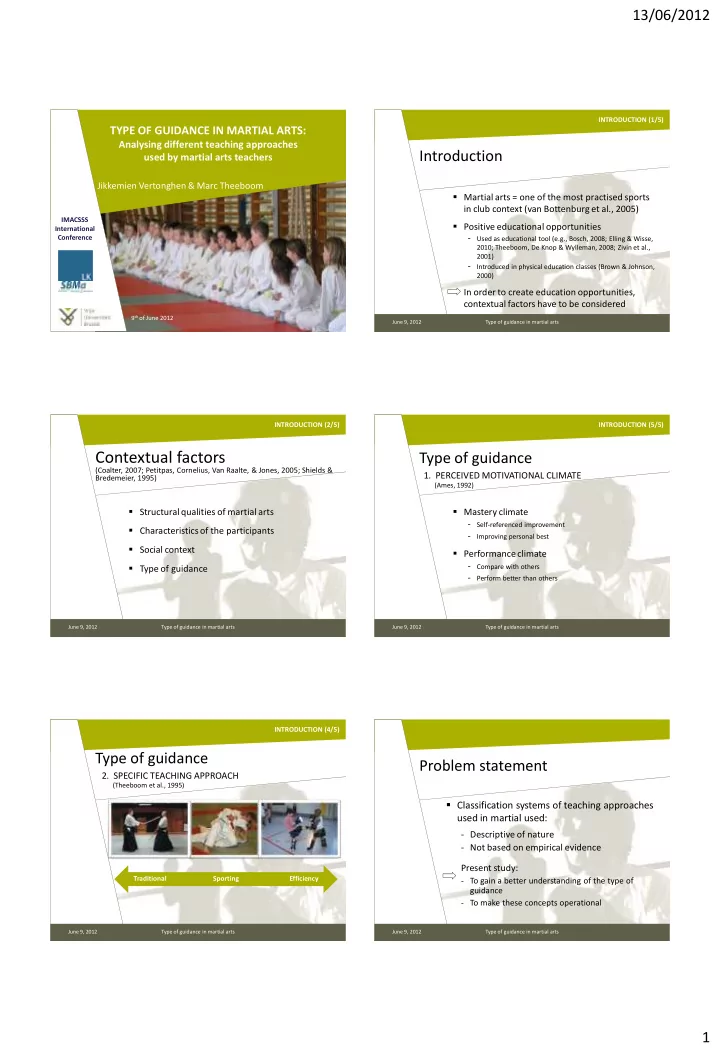

13/06/2012 INTRODUCTION (1/5) TYPE OF GUIDANCE IN MARTIAL ARTS: Analysing different teaching approaches Introduction used by martial arts teachers Jikkemien Vertonghen & Marc Theeboom Martial arts = one of the most practised sports in club context (van Bottenburg et al., 2005) IMACSSS Positive educational opportunities International Conference - Used as educational tool (e.g., Bosch, 2008; Elling & Wisse, 2010; Theeboom, De Knop & Wylleman, 2008; Zivin et al., 2001) - Introduced in physical education classes (Brown & Johnson, 2000) In order to create education opportunities, contextual factors have to be considered 9 th of June 2012 June 9, 2012 Type of guidance in martial arts INTRODUCTION (2/5) INTRODUCTION (5/5) Contextual factors Type of guidance (Coalter, 2007; Petitpas, Cornelius, Van Raalte, & Jones, 2005; Shields & 1. PERCEIVED MOTIVATIONAL CLIMATE Bredemeier, 1995) (Ames, 1992) Structural qualities of martial arts Mastery climate - Self-referenced improvement Characteristics of the participants - Improving personal best Social context Performance climate - Compare with others Type of guidance - Perform better than others June 9, 2012 Type of guidance in martial arts June 9, 2012 Type of guidance in martial arts INTRODUCTION (4/5) Type of guidance Problem statement 2. SPECIFIC TEACHING APPROACH (Theeboom et al., 1995) Classification systems of teaching approaches used in martial used: - Descriptive of nature - Not based on empirical evidence Present study: Traditional Sporting Efficiency - To gain a better understanding of the type of guidance - To make these concepts operational June 9, 2012 Type of guidance in martial arts June 9, 2012 Type of guidance in martial arts 1
13/06/2012 Aim of the study 1. Analyse different teaching approaches + develop a framework to identify these Aim approaches 2. Examine how youngsters experience the teaching approach perceived motivational climate June 9, 2012 June 9, 2012 Type of guidance in martial arts June 9, 2012 Type of guidance in martial arts METHOD (1/3) Method 1 Qualitative methodology Interview + observation of 20 teachers Method (aikido, karate or kick-/Thai boxing) Teaching Approach in Martial Arts framework (TAMA) June 9, 2012 June 9, 2012 Type of guidance in martial arts June 9, 2012 Type of guidance in martial arts METHOD (2/3) METHOD (3/3) TAMA TRADITIONAL EFFICIENCY Method 2 1. Goal of teaching Striving for unity between Sporting activity with the focus on internal (spiritual and mental) physical aspects 1 2 3 4 5 and external (physical) elements + pedagogical oriented aims 2. Duration opening and Longer than one minute 5 There is no ritual 1 2 3 4 Quantitative methodology closing ritual 3. Ability groups Martial artists are not divided 5 Martial artists are divided into 1 2 3 4 into ability groups ability groups Perceived Motivational Climate 4. Teaching techniques Teaching techniques in different 5 Teaching techniques in their whole 1 2 3 4 parts (analytical) (global) in Sports Questionnaire-2 (Newton, Duda & Yin, 5. Sparring Only one person attacks + they 5 Both persons attack and want to 1 2 3 4 2000) have to help each other win 6. Use of traditional or Hold on to traditional techniques 5 Tolerate adjustments if a technique 1 2 3 4 204 youngsters efficient techniques can be more efficient 7. Response to Intrinsically and mentally Extrinsically and physically oriented inappropriate oriented punishments (e.g., punishments behaviour motivate verbally ...) 1 2 3 4 5 4= Physical punishments (push ups ...) 5 = Suspend someone June 9, 2012 Type of guidance in martial arts June 9, 2012 Type of guidance in martial arts 2
13/06/2012 RESULTS (1/4) Type of guidance TAMA + INTERVIEWS Calculated total score on TAMA 3 groups RESULTS June 9, 2012 June 9, 2012 Type of guidance in martial arts RESULTS (2/4) RESULTS (1/4) RESULTS (3/4) Totale score Subjects (min = 7, max=35) Aikido 1 7 Type of guidance: Aikido 3 9 GROUP 1: Aikido 4 11 TRADITIONAL TAMA + INTERVIEWS Aikido 2 12 Karate 2 12 Karate 3 13 Calculated total score on TAMA 3 groups Aikido 5 14 Karate 7 16 Goal of teaching: Karate 5 18 - Traditional approach: Karate 10 20 GROUP 2: Karate 6 21 • Pedagogically oriented aims SPORTING Karate 9 22 • Traditional aspects Kick-/Thai boxing 3 24 - Sporting approach Karate 4 26 • Objectives of traditional approach, but sporting aspects Karate 1 27 more important Kick-/Thai boxing 2 29 - Efficiency approach GROUP 3: Karate 8 30 • Participating in competition EFFICIENCY Kick-/Thai boxing 4 31 • Effectively performing a technique Kick-/Thai boxing 1 34 Kick-/Thai boxing 5 35 June 9, 2012 Type of guidance in martial arts RESULTS (4/4) Type of guidance PERCEIVED MOTIVATIONAL CLIMATE 5,0 4,5 4,0 Mean score CONCLUSIONS 3,5 Traditional 3,0 Sporting 2,5 Efficiency 2,0 1,5 1,0 Performance Mastery Type of guidance in martial arts June 9, 2012 June 9, 2012 Type of guidance in martial arts April 26, 2011 The Analysis of Contextual Factors in Youth Martial Arts Practice 19 3
13/06/2012 CONCLUSIONS (1/2) CONCLUSIONS (2/2) Conclusions Conclusions Participants perceived teaching approaches Different teaching approaches can be observed differently in: - Performance climate: - different martial arts (traditional: aikido; traditional + sporting < efficiency approach efficiency: kick-/Thai boxing) A performance climate has been linked to - one martial arts style (traditional, sporting + maladaptive cognitive and affective responses efficiency: karate) Efficiency approach less appropriate to teach martial arts to children? June 9, 2012 Type of guidance in martial arts June 9, 2012 Type of guidance in martial arts Thank you for your attention! 4
Recommend
More recommend